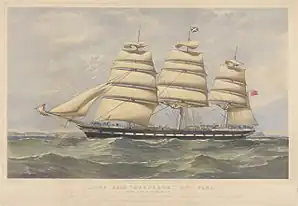Hesperus (clipper ship)
Hesperus was an iron-hulled, three-masted, passenger clipper ship that was built in Scotland in 1874 and scrapped in Italy in 1923. She was built for Thompson and Anderson's Orient Line service between Great Britain and South Australia.
 Hesperus under way | |
| History | |
|---|---|
| Name |
|
| Namesake |
|
| Owner |
|
| Port of registry | |
| Builder | Robert Steele & Company, Greenock |
| Yard number | 82 |
| Launched | 20 November 1873 |
| Completed | 1874 |
| Identification |
|
| Fate | Scrapped 1923 |
| General characteristics | |
| Type | iron-hulled clipper |
| Tonnage | 1,777 GRT, 1,574 NRT |
| Length | 262.2 ft (79.9 m) |
| Beam | 39.5 ft (12.0 m) |
| Depth | 23.5 ft (7.2 m) |
| Propulsion | sail |
| Sail plan | full rig |
| Notes | sister ship: Aurora |
In 1890 she was converted into a training ship. In 1899 she was sold to the Russian Empire and renamed Grand Duchess Maria Nikolaevna. In 1921 she was bought by British owners and renamed Silvana.
Building
Robert Steele & Company built Hesperus in Greenock, Scotland, launching her on 20 November 1873 and completing her in 1874. She was built to replace Thompson and Anderson's clipper Yatala, which had been wrecked in the English Channel in 1872. Captain John Legoe, who had been Master of Yatala, supervised Hesperus' construction.
Hesperus was the first Orient Line ship to have an iron hull.[1] Her registered length was 262.2 feet (79.9 m), her beam was 39.5 feet (12.0 m) and her depth was 23.5 feet (7.2 m). Her tonnages were 1,777 GRT and 1,574 NRT.[2] She had three masts and was built as a full-rigged ship.[3]
Her first owner was James Anderson of Thompson and Anderson, who registered her in London. Her United Kingdom official number was 68500 and her code letters were MNDL.[4]
Career
John Legoe was Hesperus' first Master. On her maiden voyage she took 340 migrants to Adelaide.[5] On the voyage, someone aboard produced a slim and modest newspaper called The Hesperian.[6]
Her last voyage under Captain Legoe brought his wife, daughter and three sons to settle in South Australia. She left London on 18 July 1877 and reached Adelaide shortly before 15 October. Other passengers on that voyage were Colonel Downes, for many years military commandant in Adelaide, and later in Victoria, and C. Angel, later an Adelaide stockbroker.
.jpg.webp)
The Orient Line sent Captain Thomas Row Harry to command Hesperus on her return voyage. He remained master of Hesperus until 1886.
The ship's log book, the last prepared by the captain, was a prized possession of one of Captain Legoe's sons.[7]
In 1890 Hesperus Joseph Moore of Devitt and Moore bought Hesperus, had her converted into a training ship, and registered her in Aberdeen Harbour. Captain John Howard Barrett became her Master.[8]
In 1899 the Imperial Russian Government bought Hesperus as a sail training ship on the Black Sea. She was renamed Grand Duchess Maria Nikolaevna after the newborn third daughter of Tsar Nicholas II and Tsarina Alexandra, and was registered in Odessa. In 1913 Swan, Hunter & Co on the River Tyne in England re-fitted the ship for her Russian owners.[3]
In 1921 the London Steamship and Trading Corporation bought Grand Duchess Maria Nikolaevna, renamed her Silvana and registered her in London.[9] She sailed from Birkenhead in merchant service but was commercially unsuccessful. By September 1922 she had been seized for debt.[1] She was scrapped in Genoa in 1923.[3]
Some other clippers on the England to Adelaide run
Sister ship
Hesperus had a sister ship, Aurora, that Robert Steele & Co launched in 1874. She was lost near the Azores in 1875 when her cargo of wool caught fire.[10] Her Master, Adam Johnston, was cleared of blame.[11]
References
- "The Old Hesperus". The Register. Vol. LXXXVII, no. 25, 554. Adelaide. 21 November 1922. p. 6. Retrieved 13 April 2017 – via Trove.
- Lloyd's Register of British and Foreign Shipping. London: Lloyd's Register of British and Foreign Shipping. 1874. HER. Retrieved 27 May 2022 – via Internet Archive.
- "Hesperus". Scottish Built Ships. Caledonian Maritime Research Trust. Retrieved 27 May 2022.
- Mercantile Navy List. 1875. p. 274. Retrieved 27 May 2022 – via Crew List Index Project.
- "Arrival of the English Mail". The South Australian Advertiser. Adelaide. 6 April 1874. p. 3. Retrieved 3 April 2017 – via Trove.
- "A Floating Printing Office". The Bunyip. No. 478. Gawler. 15 May 1874. p. 3. Retrieved 13 April 2017 – via Trove.
- "Memories of the Hesperus". The Register. Vol. XCII, no. 26, 896. Adelaide. 29 October 1927. p. 5. Retrieved 3 April 2017 – via Trove.
- "The Hesperus". The Sydney Morning Herald. No. 16, 472. Sydney. 8 January 1891. p. 4. Retrieved 13 April 2017 – via Trove.
- Lloyd's Register of British and Foreign Shipping. London: Lloyd's Register of British and Foreign Shipping. 1923. SHE–SIM. Retrieved 27 May 2022 – via Internet Archive.
- "Aurora". Scottish Built Ships. Caledonian Maritime Research Trust. Retrieved 27 May 2022.
- "Loss of the Aurora". The Adelaide Observer. Vol. XXXII, no. 1769. Adelaide. 28 August 1875. p. 10. Retrieved 4 April 2017 – via Trove.
External links
- Fernandez, Roy; Spurling, Jack. "I. Blackwall passenger ships". Ship portraits – the paintings of Jack Spurling and Antoine Roux and his three sons, painters of Marseilles. Retrieved 13 April 2017. – painting of Hesperus and some notes on her history